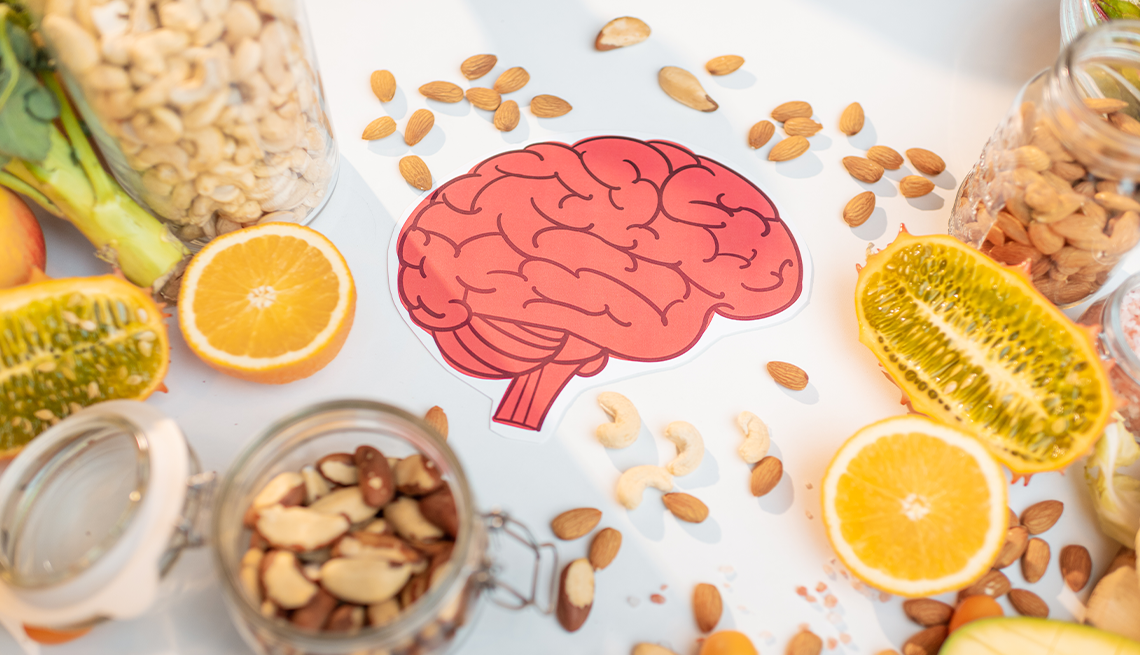According to Frontiers in Aging Neuroscience (2018) *, more than half of Parkinson’s patients, 45% of stroke survivors, and 33% of MS patients are at risk for malnutrition. Among older adults, the risk of malnutrition is 10% higher in those with dementia than those without it. These statistics are fairly alarming, based on the number of seniors who live alone. “Malnutrition is an important issue, but even physicians and neurologists don’t always take the lead in addressing it with their patients and the patients’ families,” says Bruce Soloman, DO, clinical assistant professor of Neurology at the University of Florida College of Medicine.
The risk of malnutrition increases for people with neurologic conditions because of tremors, poor coordination, slow movements, swallowing problems, too much saliva, constipation, dulled appetites, drug side effects, or food-drug interactions. All these factors make it harder to prepare and eat nutritious food. Depression and anxiety, symptoms of many neurologic conditions, also can make food preparation seem daunting. If you or your loved one unintentionally loses more than 5% of body weight in a short period of time, discuss it with the neurologist. You should mention other factors, such as avoiding meals, coughing or choking while eating or drinking, feeling bloated, experience digestive system upset or constipation that makes eating food more difficult. You will feel more energized and stronger, ease constipation and make it easier to prevent or manage high blood pressure, sugar and high cholesterol with a proper diet.
Registered dietitians recommend the following:
Drink Water: It’s easy to skimp on water without realizing it if your thirst is diminished. Sip water throughout the day rather than guzzling a big glass. For those that have trouble swallowing water or food, get a referral to a speech pathologist who can teach you swallowing techniques and determine if a thickener to beverages could make swallowing easier.
Consider the Mediterranean Diet: It includes fruits, vegetables, whole grains, lean protein and good fats and is low in added sugars, refined grains, saturated fat and alcohol. This diet also shows the best evidence for good health in neurologic conditions. Recent studies reported in Neurology (2023) suggest good fats from fish (like salmon and sardines), walnuts, and flaxseed may help protect against the cognitive decline of dementia.
Pack in Produce: Eating plenty of fruits and vegetables is associated with better functioning in neurologic diseases. Plant foods can help prevent and manage blood sugar, high cholesterol, and blood pressure, while their insoluble fiber helps regulate bowels.
Boost Aroma and Flavor: Since many neurologic illnesses cause a loss of taste and smell, using herbs and spices boosts the food’s appeal. Serve flavors from a variety of cultures and add gravies and sauces.
Eat Small Meals More Frequently: If you can’t finish a meal, divide it into portions and spread it throughout the day.
Add Extra Nutrients and Healthy Fats: Add ingredients that are high in nutrients and calories, if you are losing weight without trying. Add avocado to your salads or sandwiches and olive oil to soups and strews. Snack on nuts.
Have Back-Up Meals Ready: For days when you don’t feel physically or mentally up to making a meal, fall back on easy, healthy, no-recipe-needed meals. Family members or caregivers can freeze a few meals that you can heat and eat such as soups, stews, casseroles or chili. Add a salad and whole grain bread for a healthy meal. Post a list of these meals and all their parts on the refrigerator so you won’t forget they are available. Breakfast for dinner is always a good idea serving eggs or French toast with vegetables, fruit and yogurt.
Work with Specialists: A registered dietitian or certified nutritionist can assess your diet and identify nutrient gaps. A speech-language pathologist can assess swallowing problems and suggest solutions. An occupational therapist can help with strategies if you have tremors, weakness or other physical problems that make it challenging to use i=utensils, lift a cup or prepare meals.
Discuss Diets and Supplements with Your Doctor or Nutritionist: No special diets have been proven to help most neurologic conditions and some may even lack variety and key nutrients which can cause deficiencies. Before starting any diet or supplement, talk to your doctor. Supplements can interact with your medications and impact absorption.
Dementia Eating Strategies***
Alzheimer’s patients may find mealtime overwhelming with too many food choices, forgetting to eat or thinking they have already eaten.
Make meal times calm and comfortable
- Provide a comfortable chair/table for meals and snacks as the patient is not capable of holding food or eating off unstable surfaces.
- Serve food away from the TV and other distractions.
- Avoid tense conversations or interruptions during meals.
- Avoid rushing around the kitchen while the patient eats (sit with the patient).
- If a patient knocks over a glass or otherwise makes a mess, do not comment negatively or express alarm to avoid anxiety.
Schedule regular meal and snack times
- Patients commonly think they have already eaten so serve meals and snacks at the same time each day.
- Don’t ask the patient if he/she is hungry. Guide them instead by saying, “It’s time for our lunch (snack, etc).”
Limit distractions as changes in visual and spatial abilities make it tough to distinguish food from other things.
- Keep the table setting simple
- Keep distracting clutter off the table (mail, flower pots, hobbies, etc)
- Avoid patterned plates, tablecloths and placemats
- Use only the utensils required for the meal to avoid confusion.
- Use divided plates and a simple, light-weight covered cup for liquids
Distinguish food from the plate.
- Serving cottage cheese on a white plate makes it difficult for the patient to see it.
- Salads look like a mess. Try serving the vegetables of a salad separately and cut in small cubes.
Check the food temperature
- Test food/beverage temperatures to ensure taste quality and prevent burns.
Offer one food item at a time
- Patients may not be able to decide between the foods on the plate so serve only one or two foods at a time. For instance, serve mashed potatoes followed by the entrée.
Be flexible with food preferences
- Patients may suddenly develop food preferences or dislike those they preferred in the past.
Allow plenty of time to eat
- Keep in mind it may take an hour or two for the patient to finish a meal.
Eat together
- Provide the opportunity for the patient to eat with others as being social at mealtimes can encourage patients to eat.
Encourage independence
Make the most of the patient’s abilities. Adapt serving dishes and utensils to make eating easier. Try serving food in a bowl instead of on a plate. You might try a divided plate or one with a rim or protective edge. A spoon with a large handle may be easier to use than a fork or even allow them to use their fingers.
Serve bite-sized finger foods that are easy to pick up. Cut everything into bite-size cubes. Some examples are chicken nuggets, tuna sandwich, orange segments, broccoli or cauliflower pieces, cucumber slices, boiled eggs, cookies, etc.
Help them eat if necessary. Try hand-over-hand feeding where you put your hand over the patient’s hand to lift the food to the mouth.
Don’t worry about neatness. It’s important for the patient to feel independent. Set bowls and plates on a non-skid surface such as a placemat or towel. Use cups and mugs with lids to prevent spilling. Fill glasses half full and use bendable straws. Use an adult bib for easier clean-up.
Poor appetite can be caused by a number of factors:
- Not recognizing the food: The patient may no longer recognize the food you put on the plate.
- Forgetting how to use the fork, knife or spoon.
- Poor fitting dentures: Eating may be painful but the patient may not be able to tell you this so visit the dentist and make sure the dentures fit properly.
- Medications: New medications or a dosage change may affect appetite so contact the doctor.
- Not enough exercise: Encourage simple exercise such as going for a walk, gardening or washing dishes to stimulate the appetite.
- Decreased sense of smell and/or taste: The patient may not like the taste or smell of the food.
- Prepare foods that are not difficult to eat. Grind foods, cut into bite-size pieces and serve soft foods like applesauce, pudding, masked potatoes, and scrambled eggs. Avoid foods difficult to chew like raw carrots.
- Be alert for signs of choking. Encourage the patient to sit up straight with his/her head slightly forward. Check the patient’s mouth at the end of the meal to make sure all food has been swallowed. Learn the Heimlich Maneuver in case of emergency.
- For a decreased appetite, try to prepare some patient favorites and offer a wide variety to increase their interest.
If you or your loved one is unable to get proper nourishment and could use food assistance, contact Meals-on-Wheels,**** a free, home-delivered meal service for seniors. Hunger is real. They are a great partner to help combat mal-nutrition in the aging population. The power of a knock on the door can change lives. If you can, donate or volunteer. The frequent in-home visits provide unique opportunities to meet the nutritional needs, combat social isolation, address safety hazards and provide holistic care to those who need it.
Authored by Judy Harrison, POM Homecare
Healthy, high-calorie, easy-to-prepare recipes
*Brain and Life, Neurology for Everyday Living (April-May 2023)
*Frontiers in Aging Neuroscience (2018)
*Alzheimer’s Association
*Meals on Wheels.org











